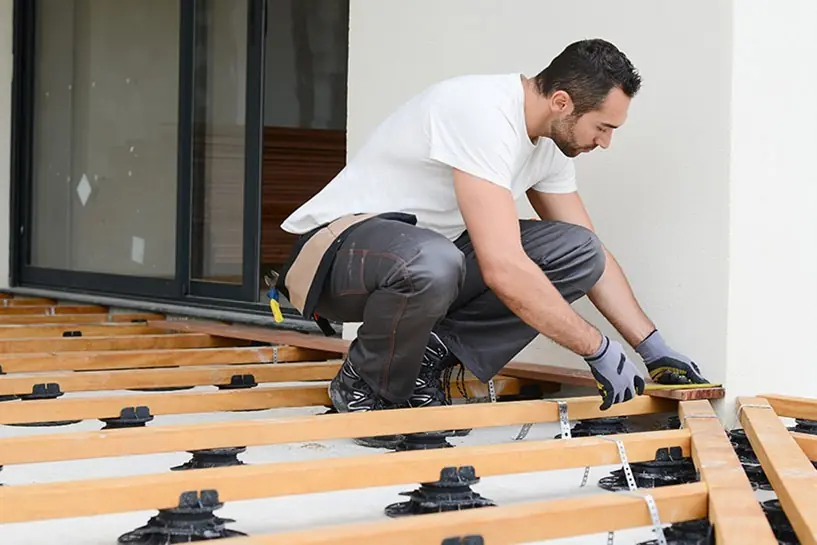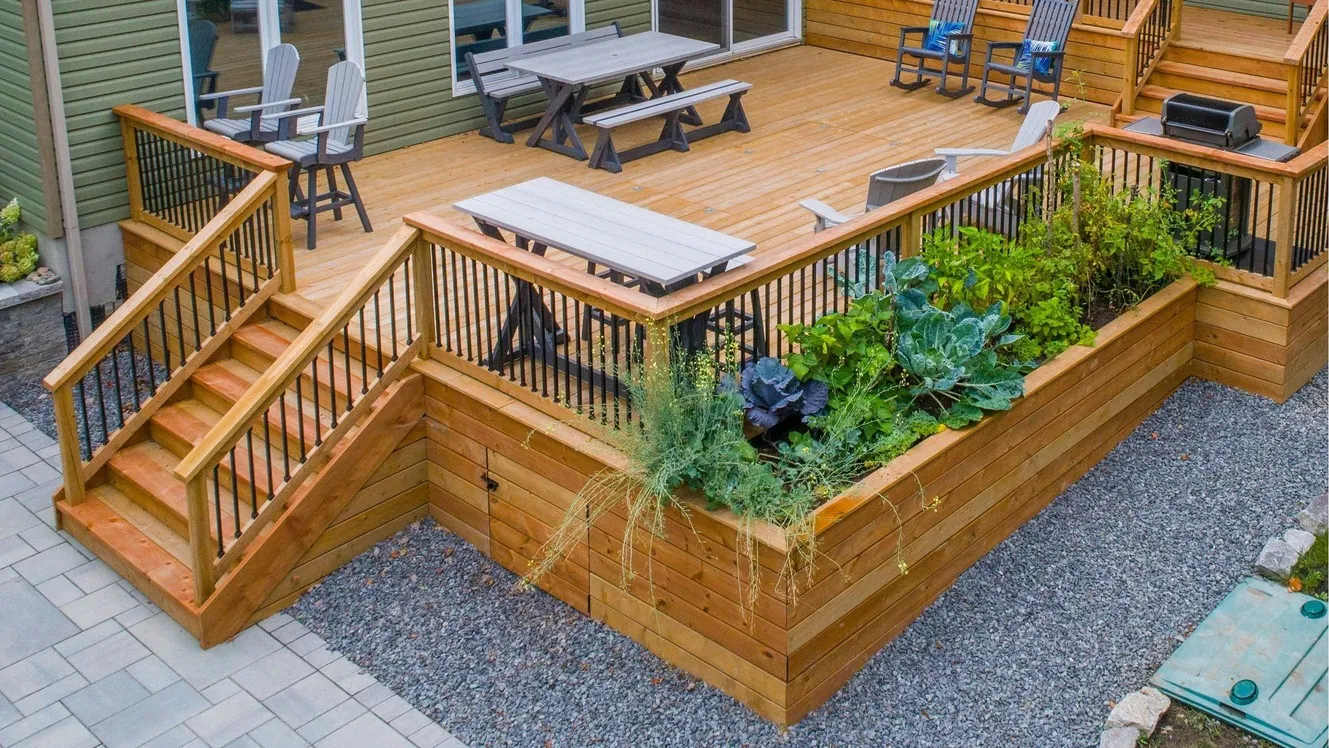A Guide to Planning Springtime Deck Construction
Springtime is all about cleaning, going for bike rides, hiking, maybe restarting your garden, and enjoying the return of the warmth. However, is it also the best time for spring deck construction?
The spring and summer seasons are some of the best times to build a new deck. Beginning deck construction in the spring likely means you’ll have a new deck right as the summer season hits.
In addition, choosing to build decks during this season is also more practical, as it is more economical, eco-friendly, and less of a hassle because of lower temperatures. Let this Oakio guide teach you the proper planning for a spring deck construction.

What Are the Basics in Constructing Decks?
Deck construction has drastically changed. It is totally different now from several years ago. There are two leading materials for decks today: wood and composite.
Basically, wood requires fewer materials, can offer your decks a more natural look and feel, and is cheaper than composite. However, despite that, composite beats wood for being more environmentally friendly, durable, and attractive. It also does not require a lot of maintenance.
Composite decks are the better choice. While they may cost a little more than their wood counterparts, composite materials can withstand nature more intensely and generally last longer as well. Wood doesn’t usually offer the peace of mind that composites can unless you’re willing to spend more on more expensive kinds of wood, maintenance, treatment, and so on.
How to Time Your Project?
Planning spring deck construction starts with timing your project. But, what is the right way to do this? Read on.
Why is Spring Ideal for Deck Building?
Aside from the fact winter is the busiest time of the year, building a deck in wintertime isn’t always advisable. Delays can happen due to snow and cold weather conditions. There is also the difficulty of dealing with concrete in freezing temperatures and fewer daylight hours. While you might not have trouble finding a construction team to build your deck around this period because it is not a peak season, there are plenty of other concerns.
Similarly, a fall schedule comes with some caveats. Unpredictable weather and colder temperatures are not ideal, and the detritus that builds up during fall can become an added concern.
In spring, the weather conditions are best for the deck materials. Ideally, however,you should start construction some time after the ice and snow have melted. Deck contractors are more active during spring as well. The peak season for construction is generally summer too—which means you might just catch the good construction companies right before they end up in other projects.
How Should You Plan Ahead?
Be sure to set a timeline for the construction and consider the climate conditions for your project.
What Permits and Regulations Should You Consider for Springtime Deck Building?
Though the best deck contractors are capable of handling your spring deck construction from square one to finish, including securing most of the necessary permits, it is still important for you to be hands-on.
What Should You Know About Local Building Codes?
Before you build a deck, you should be aware of every building code in your area to avoid paying hefty fines and starting over. This is especially true if you’re building the deck yourself. If you plan to hire a contractor, make sure that everything they build is up to code.
For example, in the United States, any structure that alters or modifies the exterior of your property or has square footage over a particular threshold will require permits. Different neighborhoods and homeowners’ associations may also have varying rules on aesthetics.
Consulting with Local Authorities
Steps to acquire the necessary permits vary from country to country, city to city. But, here’s a good example. In New York City, for instance, where new constructions take place daily, a permit must be issued by the Department of Buildings. The state-licensed professional engineer or registered architect must be able to secure the permits before the work commences. There are several types of permits depending on your project, from construction to plumbing permits. Overall, it is crucial to consult the contractor about this matter to ensure smooth sailing.
How to Budget Your Spring Season Deck Building?
After you’ve secured your permit, you’ll go through the budgeting stage. Here’s what you need to know:
Estimating Costs
- Material costs: If you’re going for natural wood, the least expensive option is pressure-treated pine at approximately $3 to $6 per square foot. The more exotic hardwoods, such as Ipe, can cost as much as $15 per square foot. Composite decking can cost around between $5 and $13 per square foot. Use this decking calculator by Oakio to give you an idea of the cost.
- Labor costs: Between DIY spring deck building and hiring professionals for this project, the first option is more economical. However, are you sure you can carry out the construction well? The labor costs depend on the scope of your project, the credibility of the contractor, and how many years they have spent in the industry.
How Can You Minimize Expenses While Ensuring Quality?
These tips will help you lower your expenses while ensuring you get high-quality deck construction:
- Plan and budget carefully: Meticulous planning is the key to avoiding unnecessary wastage of materials.
- Research composite deck brands and their materials: Make sure to choose a reputable vendor, such as Oakio, when choosing a supplier of decking materials.
- Invest in durable materials: While you will need to exhaust more budget when choosing durable materials, know that this will provide you with longer-term savings.
- Reduce the design complexity: If you wish to reduce costs, simplicity works. If that’s not your style, be ready to invest a little bit more for aesthetics.
- Work on the project during the off-season: Springtime is considered an off-season for deck building, which will allow you to save a little more.
How to Design Your Dream Deck?
Now that you have a concrete plan and timeline, as well as you have secured the necessary permits and got the idea of the costs, it is time to design your dream deck.
Finding Inspiration
While it is still best to contact a designer, it isn’t wrong to create a design yourself. However, make sure to consult the right experts about your preferred designs—there may be engineering concerns, architectural issues, and so on.
There are a lot of design inspirations nowadays from online platforms, such as Pinterest. For composite decking, these design ideas are trendy:
- Mixing your color options and finishes
- Employing laying patterns
- Building steps as statement pieces
- Incorporating tiered areas and curves
- Building a pergola
- Decking around a pool
- Building your deck around planting
Creating a Functional Layout
Aesthetics are important, but functionality should not be neglected. After your deck is constructed, you will need to think about the placement of your furniture. You may also incorporate features such as built-in seating or planters, as well as fixtures, grills, fire pits, and more.
What Are the Best Practices When Preparing Your Site?

Site Assessment and Preparation Steps
Before beginning your springtime deck building, assess your sire by verifying property lines and checking for existing structures and features that may affect the construction. Clear the vicinity of debris, trees, and other obstacles. When you can level the ground, do so. Proper preparation guarantees a seamless construction process and long-lasting results.
How to Choose the Right Location?
The location makes all the difference in spring deck constructions. Consider choosing a space that will be exposed to sunlight during the day. Privacy is also essential, so pick a spot away from view. Accessibility is also paramount so choose areas near entry points for convenience.
What Are the Materials and Tools to Prepare?
While these are generally the work of the decking contractor, it isn’t wrong to stay on top of your project.
What Are the Essential Materials?
- Post holes and framing: Concrete mix, anchor bolts, post anchors, cardboard post forms, two-by-four boards, nails, ledger board, lag screws, four-by-four posts, center beam, joist hangers, mason’s string, and wooden stakes.
- Decking, fascia, and end caps: Composite deck boards, starting and ending accessories, deck screws or hidden fastening system, white chalk, fascia boards, end caps, and water or silicone sealant.
What Are the Tools Required for the Job?
If you’re building your composite deck DIY, here are some of the must-have tools:
- Tape measure
- Circular saw
- Jigsaw
- Miter saw
- Chalk line
- Clamps
- Hand saw
- Safety glasses
Installation Process Overview(The Step-by-Step Installation Guide)
Oakio’s composite deck construction comprises six steps.
- Step 1: Build up the flat ground – Ensure the ground is level and free from all kinds of debris.
- Step 2: Install the joist – After you finish the ground base, go ahead and set up the joist on the ground. Remember to leave proper space across the joists. Then, you can pre-drill a hole on the joist according to the screw location of your WPC decking.
- Step 3: Install the WPC decking – First, attach starter clips to the joists along the perimeter to create a strong starting point. Make sure to leave ample space between the starter clip and the wall. Then, place the first WPC decking board onto the starter clips. After finishing the first WPC board, you can start installing the remaining boards one after the other while maintaining consistent gaps. Cut boards if necessary. After finishing the installation of the last piece of decking, you can install the last few pieces of WPC decking.
- Step 4: Set up the decks at various angles – When installing your WPC decking at various angles, simply switch the angle and follow the same installation methods as mentioned in the previous step.
- Step 5: Set up the fascia – The fascia is in charge of covering the bare side of the decking, preventing moisture from destroying the deck’s interior. If desired, fascias may be installed, but this is optional.
- Step 6: Check the overall situation of your deck – Before using your newly constructed deck, clean it with a mild soap and water solution.
Are There Maintenance Considerations Post-Construction?
Yes, there are. It starts with routine maintenance and continues with regular inspections.
Routine Maintenance Tips
Regularly cleaning and sealing your deck reflects the level of care for this valued part of your property. Beyond those, you may also ventilate the underside of your deck, avoid rugs and mats with rubber backing as these are moisture traps, scrub grease, and use furniture pads for redecoration time. Following these helps prolong the life of your composite deck.
How to Inspect Your Composite Deck in Spring?
A full-scale deck inspiration must be done at least once a year. If you’re choosing to inspect in spring, take a moment to ascertain stains, mold, or mildew spots, which may require attention during the cleaning process. Moreover, check for any loose boards or screws that need troubleshooting.
Plan Your Springtime Build with Oakio
This comprehensive guide for your spring deck construction has elaborated on the importance of detailed planning as a prerequisite for constructing the most beautiful composite deck. Planning ahead, budgeting well, knowing the materials needed, ensuring the right installation, and keeping it clean thereafter are likewise crucial. Adhering to these guidelines will provide you with a deck that lasts beautifully and stands the test of time.
Plan your springtime build now with Oakio. This brand is one of the world’s leading providers of innovative composite decks. Its composite decking solutions comprise four high-quality products: Proshield, Iniwood, Matshield, and Elashield. Check out Oakio’s selections now for the deck of your dreams.
Trending Reading
What Are the Differences Between the WPC Board and PVC Board?
[2024 Update] How Long Does WPC Decking Last?












